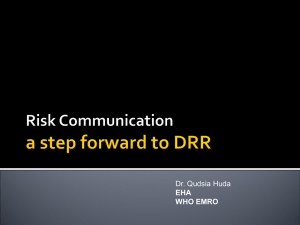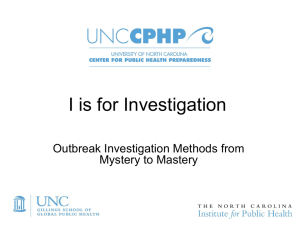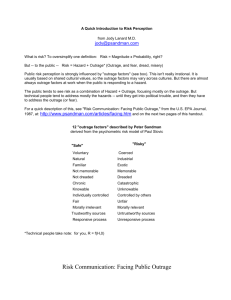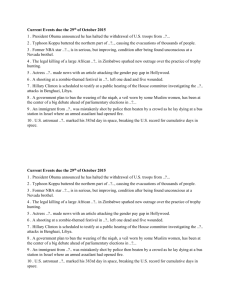Risk Communication for Salmon Aquaculture
advertisement
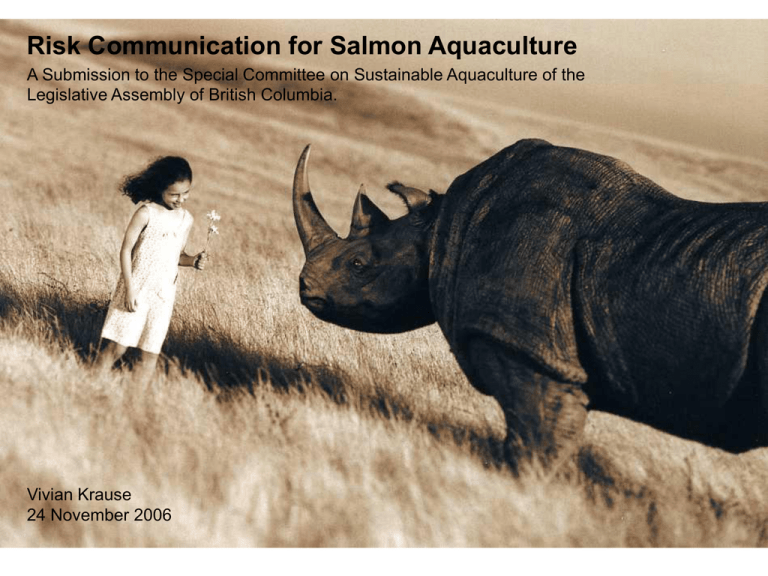
Risk Communication for Salmon Aquaculture A Submission to the Special Committee on Sustainable Aquaculture of the Legislative Assembly of British Columbia. Vivian Krause 24 November 2006 Risk Communication: A “Missing Piece” - The current review by the Special Committee on Sustainable Aquaculture is focused on economic benefits and environmental impacts. - In fact, the current controversy over salmon aquaculture is a matter of environmental issues (“Hazards”) and “Outrage” over both environmental and non-environmental issues (eg. broken trust, unfairness, no benefits, secrecy, etc.) - To succeed in its work, the Special Committee should consider both the “Hazards” and the “Outrage” over both environmental and non-environmental concerns. - Recommendations to the Legislature should include strategies to mitigate both the environmental “Hazards” as well as strategies to address the “Outrage” of communities and stakeholders. - Risk Communication is a formal scientific approach for communicating about risk, and for handling “Outrage.” What is Risk Communication? Risk Communication is a science-based approach for communicating effectively in high-stakes, emotionally charged, controversial situations. "The ultimate job of risk communication is to try to produce a citizenry that has the knowledge, the power, and the will to assess its own risks rationally, decide which ones it wants to tolerate and which ones it wants to reduce or eliminate, and act accordingly." - Dr. Peter Sandman Reference: Sandman, P. Responding to Community Outrage: Strategies for Effective Risk Communication. AIHA Press. 1993. Facts: Historically, perceived hazards and "real" hazards have not been the same. There has been virtually no correlation (r=0.2) between the ranking of a threat or hazard by the general public and the ranking of those same hazards by technical experts. The correlation has been very low between how dangerous a hazard truly is, how many people it upsets and how badly it upsets people. "Many problems judged to be of relatively low risk have been receiving extensive public attention and federal resources meanwhile the environmental problems that the experts judged to be of higher risk, such as air pollution, received far less attention and less resources.” - The U.S. Environmental Protection Agency Common responses to this apparent irrationality: 1. People are ignorant or irrational so just ignore them. (Stone-walling). 2. The public needs to be better educated, lets "tell our story." (Better communication). 3. The public is manipulated by activists and the media. A beleaguered industry should say so and ”fight the propaganda war better.” 4. The public is right. Experts are wrong. Government should base public policy on public opinion - even if the experts disagree. Risk Communication is a better approach. "Good risk communication can not always be expected to improve a situation but poor risk communication will nearly always make it worse.” - The National Resource Council. 1989. Risk Communication requires an understanding that the public takes a broad view of risk. Experts and the public define risk differently. Likewise, companies and communities do not view risks in the same way. “People are disturbed not by things but by their view of them.” - Epicteus, First Century Philosopher. Research shows that people tend to be more accepting and take a “rose-tinted view” if a risk is: • “Natural” (not industrial), voluntary, familiar, and not new. • If we trust the perpetrators of the risk and they have a good track record. • If we get benefits in association with the risk and if it is deemed to be a fair risk. • If the potential negative consequences are common, certain, reversible and not memorable. • If we have no personal stake in it, there are no identifiable victims, it is not dreaded, and there are no implications to future generations - especially children. • If there are no powerful negative images associated with it, and if it gets little media attention. All risks are not accepted equally. “Outrage Factors” People tend to view a risk as greater and are less accepting if the risk is: • Industrial “unnatural”, involuntary, imposed, unfamiliar and new (as is salmon farming). • If the perpetrators of the risk have a bad track record and are not trusted. • If it is considered “morally wrong.” • If we get no benefits in association with the risk, and if it is deemed to be unfair. • If the potential negative consequences are uncertain, catastrophic, irreversible, rare and memorable (as in the case of the collapse of a wild salmon run). • If we have a personal stake in it, if it’s dreaded and if there are implications to future generations, particularly children. • If there are powerful images associated with it, and if it gets media attention. In this case, we tend to take a dark view of the risk because of “Outrage Factors”. Because environmentalists push these buttons is why their campaigns are effective. Why salmon farming pushes people’s buttons: One of the reasons that there is controversy over salmon farming is because it touches on so many of the “Outrage Factors”: Industrial - Natural and industrial risks are judged on different terms. We have less tolerance for industrial risks than "Acts of God”. The bar is much higher for multi-nationals than "mom & pops." Unfamiliarity - When we think of farms, we think of barns and fences not boats and net pens. Salmon farming is new - Commercial salmon fishing has been done for more than 100 years, salmon farming hasn’t. We become habituated to risks that have been around, as if they are subconsciously “grandfathered in.” A poor track record - An industry's early track record can halo or haunt it. Trust - The most important factor in risk perception is trust. “The more we trust, the less afraid we will be; the less we trust, the more afraid we will be.” Morality - Wild salmon are sacred. It is considered morally wrong to put them at risk. No or few benefits - When we receive benefits, our views change. Hence, people who work in an industry are naturally more inclined to be more supportive of it. Not only they benefit from it, their involvement makes them more familiar with it. Less unknown makes for less to fear. Unfairness - We are less accepting of risks when people/communities seem unfairly exposed. Catastrophic potential - As in the case of the collapse of a wild salmon run, catastrophes gauge the fabric of our environment and our society more than events that are dispersed in place and time. We are more leery of risks that are potentially catastrophic than chronic risks. Uncommon events - Rare events are seen as more serious than prevalent events that we have become accustomed to. As salmon farm escapes become more rare, paradoxically, they should be expected to cause not less but more alarm each time. Irreversibility - Risks that are feared to have irreversible consequences, such as the extinction of a wild salmon run, are judged to be greater and are less readily accepted. A personal stake - When something near and dear to us is at stake or we are personally at risk, we naturally have a worse perception of it. Future generations affected - Risks that have delayed effects or effects on future generations are judged more harshly and are less readily accepted. Identifiable victims - For example, the affected communities and wild salmon stocks of a particular region such as The Broughton Archipelago. Powerful images - Sea lice are becoming the mushroom cloud of salmon farming; we are familiar with flies on horses and cows but not with bugs on fish. Media attention - The public tends to think of the media as a watch dog that alerts us when public interests are at stake. When something gets repeated news coverage, people assume that "where there's smoke, there's fire,” even without analyzing the news coverage. “Give a lie a head start and the truth will never catch up.” - Michael Moore. Outrage taints our perception of hazards When people are concerned or upset, they have difficulty hearing, understanding and remembering. This can reduce people's ability to process information by up to 80%. When people are concerned, they often distrust people - even those who are listening, caring, honest, open-minded and knowledgeable. When people are concerned, negative information outweighs positive information and negative perception becomes reality. People who are outraged are more prone to misperceive risk. People make assumptions about how a company treats the environment based on their own observations and also on how a company treats the local community and in particular, the environmentalists. Caught in the cross-fire between an angry community and an industry, the public will have difficulty believing that the industry cares about the environment if the industry appears to have contempt for the environmentalists. Emotional footprints obscure environmental footprints. Outrage festers and transforms When longstanding grievances are not addressed, other issues may become a vehicle through which redress is sought. It is easier to shut down a site or a company because of how it treats the environment than because of how it treats a community. When the only grounds on which a company or an industry can be defeated are environmental issues, there is a risk that this becomes the battleground. Anger over broken trust, lack of benefits, unfairness, double standards, inconsistencies, secrecy, bias, discourtesy and not being listened to become "behind-the-scenes" issues. “The most important part of communication is hearing what isn’t said.” - Peter Drucker What you can and can’t control Risk management and risk communication require differentiating between what you can and can’t control, and focusing on what you can. Many psychosocial factors influence risk perception and are beyond control: heuristics (mental shortcuts), over-confidence or unrealistic optimism (“it won’t happen to us), cognitive abilities, preference for certainty, and reluctance to change strongly held beliefs. Most of the other factors that affect risk perception are also beyond control (age, gender, race, socio-economic status, education, world view, lifestyle, etc.) One of the few factors that a government or industry can influence is whether it provokes or stokes Outrage. While most of what determines the public response to risk is beyond control, how companies interact with communities is very much in their control. To understand and resolve a risk controversy, it helps to conceptualize risk in the terms of Dr. Peter Sandman: Risk = Hazard + Outrage Where, Hazard = Environmental, food safety & other “technical” issues and Outrage = Public concern. The Business Case for “Outrage Management” 1. High Outrage = High Risk. 2. Resources spent on mitigating hazards that provoke high concern are not then available to be spent on mitigating hazards that do not trigger as much concern (eg. climate change). 3. Under-mitigating Outrage puts pressure on governments and industries to overmitigate Hazard. That’s costly. 4. Most plaintiffs sue not to get rich but because of Outrage. 5. Unmitigated Outrage leads to Unnoticed Hazard Mitigation; you won’t get credit for mitigating hazard unless you also mitigate Outrage. Angry people won’t notice good things that you do do. 6. Prevent burn-out of the people involved. Despite the strong business case, dealing with concern and outrage is very difficult because: 1. The playing field isn't level; it feels unfair. The public’s expectations of industry and of environmentalists are not the same. 2. Its frustrating to come to grips with the fact that you’ve got to deal with outrage when what you’d rather talk about is substance. 3. Its counter-intuitive; conventional communication strategies tend to backfire. Outrage changes the rules. 4. Its new and unfamiliar. 5. It seems "un-business-like” and it doesn’t feel good. 6. Production and reputation management may be inherently at odds. Salmon Farming OverFishing Is it said to be morally wrong? x x Are we unfamiliar with it? x Is it new? x Are there powerful images against it? x Are the negative consequences memorable? x Is it “unnatural”, culturally unacceptable? x Does it have a poor, recent track record? x x Does it have catastrophic consequences? x x Are the negative consequences rare? x x Are the negative consequences irreversible? x x Is it felt to be unfairly imposed? x Are there no benefits for those exposed? x Is it involuntary or externally imposed? x Do those affected lack control? x x Do those affected mistrust the perpetrators? x x Are those affected personally at stake? x x Are future generations affected? x x Are there easily identifiable victims? x x Is it getting a lot of media attention? x x Do we dread the negative consequences? x x 20 13 Outrage scores for threats to wild salmon Total Outrage Score: Habitat Destruction Global Warming x x x x x x x x x x x x 4 7 Escapes Health Issues Sea Lice and Wild Salmon Is it said to be morally wrong? x x x Are we unfamiliar with it? x x x x x x Are there powerful images against it? x x x Are the negative consequences memorable? x Outrage scores for threats to environmental issues related to salmon farming Is it new? “Polluting the ocean” x Is it “unnatural”, culturally unacceptable? x x x x x Does it have a poor, recent track record? x x Does it have catastrophic consequences? x x Are the negative consequences rare? x x Are the negative consequences irreversible? x x x x x x x x Is it felt to be unfairly imposed? x Are there no benefits for those exposed? Is it involuntary or externally imposed? x x x Do those affected lack control? x x x Do those affected mistrust the perpetrators? x x x Are those affected personally at stake? x x Are future generations affected? x x Are there easily identifiable victims? x x x Is it getting a lot of media attention? x Do we dread the negative consequences? Total Outrage Score: 6 12 x x 15 20 Much Outrage has been expressed to the Special Committee on Sustainable Aquaculture: • Broken trust, betrayal and suspicion of conspiracy to eliminate wild salmon • No benefits to local communities • Not being listened to, being ignored and dismissed • Secrecy, bias, discourtesy and bullying • Unfairness, double standards, inconsistencies and favouritism • Abdication of responsibility by government Broken trust, betrayal and suspicion of conspiracy "In 1987, the province came to us and asked: 'Where don't you want salmon farms?' And they created red zones…. The province said there would be no salmon farms in the red zones. In fact, they said the definition of a red zone was that they would not accept an application for a salmon farm. And then? They put more farms in the red zones than anywhere else… This was a betrayal of public trust. This is where we all started to lose confidence." "Farms and oil wells were allowed on the east coast as soon as the fishermen were gone. I cannot help but wonder if that's what this is all about." - Alexandra Morton, Echo Bay No Benefits "For sure, some communities may be benefiting, but the salmon feedlots in the Broughton, they do not put children in our school…. They don't buy gas…. They don't use our post office…. They don't bring residents to our community. They do not employ us…. And they don't respond to our requests. They're not allowed to fraternize with us." - Alexandra Morton, Echo Bay "… 4,000 jobs but it's our territory, our people that wear it." - Chief Bob Chamberlin, Alert Bay Source: Report on Proceedings (Hansard) of the Special Committee on Sustainable Aquaculture, pgs. 422, 424, 423, 363. Not being listened to, being ignored and dismissed "The only time I think were going to be listened to is if we resort to direct action, and then the government and the media and the public will characterize us as a bunch of crazy Indians." - Chief Bob Chamberlin, Alert Bay "I don't think there's one farm that we agreed to." - Bill Cranmer, Alert Bay Secrecy, Bias, Discourtesy and Bullying "We weren't told what the results were or what happened to them. We'd like to know. … Still we'd like to find out what those results were… They were never made public. They were never returned to us either." - Robert Mountain, Alert Bay "I also hope the scientists that are picked have no preconceived biases as this seems to be the complaint about past studies. True or not, the impression is there and it taints the work." - Jim Gordon, Campbell River "… the salmon farmers have been uncompromising. As a mom, I look at them as bullies. They do not want to listen to what all of us have been saying to them." - Alexandra Morton, Echo Bay Source: Report on Proceedings (Hansard) of the Special Committee on Sustainable Aquaculture, pgs. 360, 363, 366, 191, 419. Unfairness, Double Standards, Inconsistencies & Favouritism "If this fish farming thing was so damn good, why is it all concentrated in our area here, practically 15 or 16 miles from our island? I think what we should do is find out where all of you live, and our band will buy pig farms and put them right next door to our property. " - Arthur Dick, Alert Bay "The salmon farming industry's needs were put ahead of the needs of local people.” - Jennifer Lash, Sointula They "ignore the very same rules that they obey in Norway….They come here, and they are pretending that they don't know this.” - Alexandra Morton, Echo Bay Abdication of government responsibility "The Deputy Minister chose to look out the window of the boat that didn't look at the farm, basically pretending that there wasn't a problem. - Jennifer Lash, Sointula "This industry is running roughshod, and government officials shuffle papers and find other things to do, other than address what's really happening," "The government is turning a blind eye.” - Chief Bob Chamberlin, Alert Bay Source: Report on Proceedings (Hansard) of the Special Committee on Sustainable Aquaculture, pgs. 392, 387, 421, 397, 359. Communities that differ in terms of their views of the environmental issues, also differ in terms of their trust of the industry, whether they feel that they have been fairly consulted, whether they are benefiting economically from the industry, and many other “Outrage Factors” that influence the perception of environmental risks. Salmon farming has come a long way Salmon farming has improved substantially since the early years, meanwhile public perception is more negative now than ever. Lack of attention to the “non-environmental” issues of “Outrage” explains in part why the salmon farming industry is not “getting credit” for the numerous significant strides that have been made towards sustainability. None of this changes the sea lice findings of Alexandra Morton and others: Virtually no sea lice were found near Prince Rupert, Rivers Inlet and Smith Inlet. Only very few sea lice near the salmon farms in Bella Bella but many sea lice were found in the Broughton Archipelago. 1 louse per gram of fish is probably fatal, therefore a 0.1 g pink or a 0.35 g chum smolt probably can't survive even 1 louse. A 42-fold increase in lice was found on juvenile salmon near a farm. Elevated sea lice levels were not found until the smolts got near the farms. Elevated levels of sea lice were found for 35 km past the farms. Note: Please read the original scientific articles for important details. “In a risk controversy, both sides are usually inclined to make distortions but the consequences for the two sides are very different. Activists typically over-state risk meanwhile industry and government typically understate it. The former is irritating but much less dangerous to society.” “Risk-related decisions are grounded in value judgments about how conservative to be. These are not technical issues. These are values issues and the opinions of non-experts are as legitimate as those of experts.” “Anecdotal data provided by emotional or hostile people is still data; when scientists treat this data with contempt, they are being emotional, hostile and unscientific. “…people who are concerned or outraged are important sources of data - not just their outrage itself, but the experiences that aroused it. Ignoring what they can tell you is bad outrage management, bad public policy and bad science.” “… outrage-provoking risks merit a more thorough investigation than risks that provoke only apathy.” - Dr. Peter Sandman Source: “Because People Are Concerned: How Should Public “Outrage” Affect Application of the Precautionary Principle?” pg. 40. Please note: This paper was written in relation to the application of the precautionary principle and Outrage in general, and mobile telecommunications in particular. See www.psandman.com. " … Scientist's characteristic open-mindedness, tentativeness, and voracity for data of any sort tend to disappear when amateurs are questioning the validity of that scientist's conclusions. The scientist's normal approach to anecdotal information is to see it as a rich source of hypotheses worthy of more rigorous investigation…. As human beings, scientists sometimes fall short of these goals, but in their interactions with each other they genuinely try to live up to them. But when faced with a citizen activist - especially an activist who trusts anecdotal evidence more than statistical generalizations, and most especially an activist who is questioning the scientist's competence and integrity scientists are all too likely to lose track of these core scientific values. When there is a lot of public outrage at the experts, likelier than not there will be a lot of expert outrage at the public as well… occasionally when the citizens do have it right, it takes the experts longer than it should to notice because of their own defensiveness. … Experts should notice their disinclination to take citizen experience seriously enough and should bend over backwards to compensate for it." - Dr. Peter Sandman Source: “Because People Are Concerned: How Should Public “Outrage” Affect Application of the Precautionary Principle?” pg. 40. If Risk = Hazard + Outrage, It follows that: Mitigating Risk = Mitigating Hazard + Mitigating Outrage Risk Management is thus a two-fold task. • When Outrage is high and Hazard is low, managing Outrage is a major task. This is common. A common mistake of governments and industries is to mitigate Hazard while under-attending to Outrage. • When both Hazard and Outrage are present, mitigate both. • Mitigating Hazard does not mitigate Outrage, though many people think it does. Reducing Outrage usually has little to do with mitigating technical risks. "Hazard solutions for Hazard and Outrage solutions for Outrage." - Dr. Peter Sandman Effective strategies for addressing concern and outrage: • • • • • • • Listening, responding accordingly, acknowledging uncertainty Getting “behind the scenes” issues on the tables Sharing dilemmas, acknowledging when things are not clear cut Expressing diversity of opinion (even amongst experts and authorities) Admitting error and apologizing Resolving longstanding grievances - mitigation and compensation Commitment to not repeat the same mistakes Beyond Communication: • • • Sharing control - eg. for siting Joint research - eg. The Marine Harvest Canada and CAAR agreement. Accountability - certification A Recommendation for a Framework for Sustainable Aquaculture in BC: Risk Communication Considering that risk management is integral to sustainability, it is recommended that a framework for Sustainable Aquaculture in British Columbia include Risk Communication guided by state-of-the-art concepts and principles, including those of Dr. Peter Sandman: 1. Risk = Hazard + Outrage 2. Risk Mitigation = Hazard Mitigation + Outrage Mitigation. 3. When both Hazard and Outrage are present, mitigate both. 4. Hazard Solutions for Hazard Problems and Outrage Solutions for Outrage Problems. About the Author Vivian Krause held responsibilities for Corporate Development, North America, for NUTRECO Aquaculture (2002 - 2003), one of the world’s largest aquaculture companies with salmon farming and salmon feed production in Canada, Scotland, Norway, Chile and elsewhere. Prior to that, Vivian worked with the United Nations Children’s Fund (UNICEF) in Guatemala and Indonesia, from 1990 - 2000. She has a B.Sc. and an M.Sc., both in Nutrition, from McGill University and l’Université de Montréal, respectively. She has lived in Kitimat and Kamloops, and now resides in North Vancouver with her daughter, Zoé. This submission was inspired in large part by the work of Dr. Peter Sandman, available for review at www.psandman.com. The cover photo is by David Maisel, Untitled, Palm Press, Inc. Vivian Krause vivian.krause@mac.com 604.219.5905

